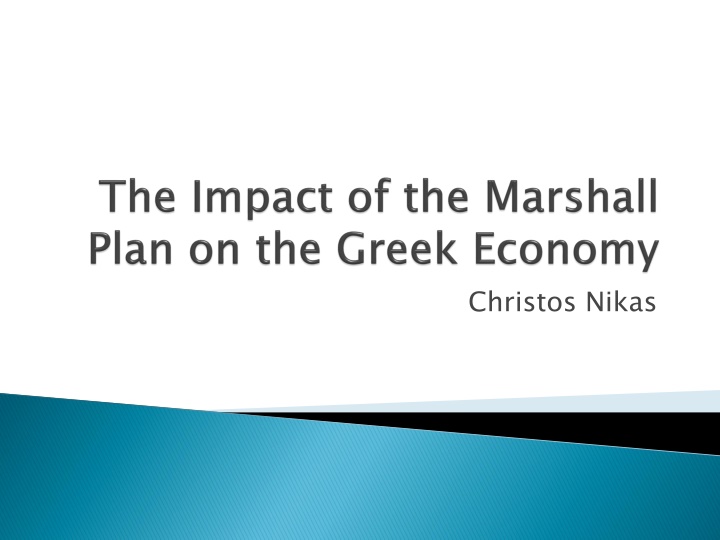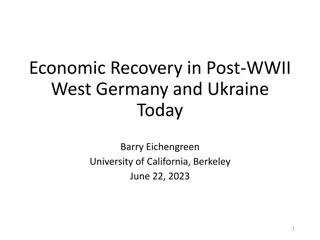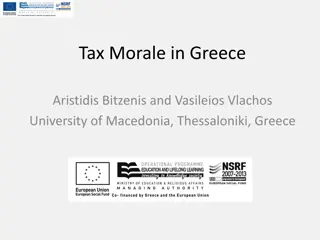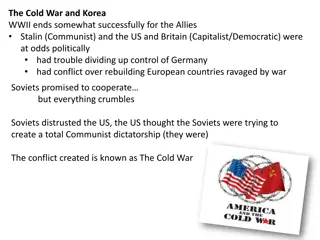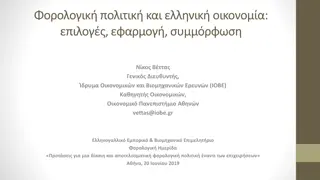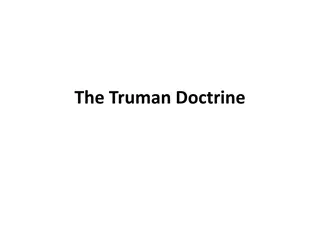Analysis of the Marshall Plan's Impact on Greece's Economic Reconstruction
Greece was a significant beneficiary of the Marshall Plan following World War II. Despite the country meeting eligibility criteria, the assistance provided by the United States did not lead to the expected reconstruction and development of the Greek economy. The influx of development aid from richer countries to poorer ones aims to address savings-investment and foreign exchange gaps, crucial for economic growth and development.
Download Presentation

Please find below an Image/Link to download the presentation.
The content on the website is provided AS IS for your information and personal use only. It may not be sold, licensed, or shared on other websites without obtaining consent from the author.If you encounter any issues during the download, it is possible that the publisher has removed the file from their server.
You are allowed to download the files provided on this website for personal or commercial use, subject to the condition that they are used lawfully. All files are the property of their respective owners.
The content on the website is provided AS IS for your information and personal use only. It may not be sold, licensed, or shared on other websites without obtaining consent from the author.
E N D
Presentation Transcript
Greece was one of the main beneficiaries of the Marshall Plan. The country obviously satisfied the two main criteria of eligibility (World War II destruction and communist threat). Greece only reached the pre-war GDP level in 1951. Furthermore the war era was prolonged by the civil war between 1946 and 1949. The intensity of the problems probably explains the scale of the assistance provided by the United States to Greece.
The amount of money Greece received from USA between 1945 and 1950 is the largest any country received relatively to its population in that period. Furthermore it exceeds the sum of all the financial flows (loans and assistance) to Greece from 1821 to 1930. Besides it s gigantic size and developmental potential however, the Marshall plan did not play the key role in the reconstruction and the development of the Greek economy one should expect. The primary goal of my presentation is the investigation of the reasons of the partial failure of the Marshall Plan Financial Assistance to Greece.
Table 1: U.S. Economic Assistance Under The European Recovery Program April 3, 1948-June 30, 1952.(Millions of USD). ________________________________________________________________________________ No Country Total Grants Loans _______________________________________________________________ 1 Austria 677.8 677.8 - 2 Belgium-Luxembourg 559.3 491.3 68.0 3 Denmark 273.0 239.7 33.3 4 France 2,713.6 2,488.0 225.6 5 Germany 1,390.6 1,173.7 216.9 6 Greece 706.7 706.7 - 7 Iceland 29.3 24.0 5.3 8 Ireland 147.5 19.3 128.2 9 Italy 1,508.8 1,413.2 95.6 10 Netherlands 1,083.5 916.8 166.7 11 Norway 255.3 216.1 39.2 12 Portugal 51.2 15.1 36.1 13 Sweden 107.3 86.9 20.4 14 Turkey 225.1 140.1 85.0 15 United Kingdom 3,189.8 2,805.0 384.8 _______________________________________________________________ TOTAL $13.325.8 $11.820.7 $1.505.1 _______________________________________________________________
The inflow of development aid represents a unilateral transfer of money from richer countries to poorer ones. According to the dual gap model, countries, especially those in the pre-take off stage of development, are faced with two gaps. The first one is the savings- investment gap (inadequate savings to finance the necessary investment). The second is the foreign exchange gap (excess of imports over exports). Growth requires capital goods which can be supplied domestically or imported.
Domestic provision requires savings and foreign provision requires imports. If they can only be provided from abroad, their import requires that foreign exchange and foreign aid can finance this import by relaxing the balance of payments constraint. The inflow of foreign exchange in the form of foreign aid could contribute to the economic development of the receiving country provided that this country can manage to use these funds in order to finance investment which will enable it to produce exportables, or investment goods to substitute imports.
In other words, the inflow of financial aid will apply for a period of time during which the receiving country will have to shift to the production of exportables and/or reduce the import content of its production. This will bridge the foreign exchange gap in the medium and long term, even if the inflow of aid ends. Otherwise aid will only bridge the two gaps temporarily and cause a further increase in the foreign exchange gap since growth will be based on increasing imports. In the context of this approach, aid is examined as a potential supply factor for economic growth in the sense that it may provide resources (in foreign exchange) for the financing of investment in receiving countries.
The preparation of the implementation started with the arrival of AMAG (American Mission for Aid to Greece) in July 1947. AMAG was eventually succeeded by ECA/G (Economic Co-operation Administration in Greece. We could divide the implementation of the program to three sub-periods: July 1948-August 1949 (end of civil war). Summer 1949-June 1950 (outbreak of Korean War. Summer 1950-June 1951. 1. 2. 3.
The financial aid provided to Greece during the first fiscal year of the implementation of the program was strictly designed to finance reconstruction. Half the financing (80.8 mil. USD) was provided as drawing rights since Greece was not considered ready to export goods to other recipient countries. A fine balance of encouraging investment without increasing inflationary pressures was achieved.
The only peace period in the implementation of the program. The pressure for defense expenditure was relaxed and major infrastructure projects (e.g. power plants) were put forward. The macro- economic stabilization of the economy was pursued through the unorthodox measure of selling golden sovereigns by the Bank of Greece in order to control inflation in drachma terms. The investment expenditure was substantial enough to transform the Greek economy from peasant to industrial and balance public finances. Greek entrepreneurs seemed reluctant or even unwilling to participate, feeling that their long-standing privileges were threatened by the ECA/G prerequisites.
The outbreak of the Korean War led Americans to reduce the amounts given to the European beneficiaries (from 274.6 to 232.7 mil. USD) since they were asked to contribute to the joint defense effort against the communist threat. Financing investment through the counterpart parts was compromised by the Greek government which could not cover it s contribution.
The basic goals of the American policy in Greece were: The defeat of the Communists in the civil war. The reconstruction of the country after the destruction caused by the wars (WWII and civil). The increase of agricultural and industrial production. The independence of Greece from foreign aid. Monetary stabilization. The support of the Greek armed forces. The modernization of the Greek public sector. There were successes and failures:
The survival and the accommodation of the refugees of the civil war. Reconstruction projects throughout the country. Covering of the trade balance and budget deficits. Expansion of the cultivated land. Industrial production growth. Reducing and eliminating the use of British sovereigns as a parallel national currency.
Table 2: Production in Western Europe 1947-1951 (1938=100) ________________________________________________________ No Country 1947 1949 1951 % Increase 1947-51 _________________________________________________________ 1 Austria 55 114 148 269 2 Belgium-Luxembourg 106 122 143 33 3 Denmark 119 143 160 35 4 France 99 122 138 39 5 Germany 34 72 106 312 6 Greece 69 90 130 88 7 Ireland 120 154 176 46 8 Italy 93 109 143 54 9 Netherlands 94 127 147 56 10 Norway 115 135 153 33 11 Sweden 142 157 172 21 12 Turkey 153 162 163 7 13 United Kingdom 110 129 145 32 ___________________________________________________________ All Countries 87 112 135 55 All Countries Except Germany 105 130 145 37 _____________________________________________________________
The attitudes of certain social groups (the business class) and the poor performance of the Greek institutions proved to be unsolvable problems. The American Economic Mission and the Greek governments had different agendas and certainly different priorities. The application of the basic principles of the New Deal in Greece failed because of the reluctance of the economic and political establishment to adopt structural changes that could threaten their privileges. The unorthodox use of the counterpart funds led to inflationary pressures rather than productive investment.
The program, as far as Greece was concerned coincided with the civil war, followed by (less than) a single year of peace and the Korean War. Eventually the program became defense rather than development oriented. The institutional underdevelopment of Greece limited the positive effects of the program. The implementation of the program was de facto interpreted by the American side as a permit to intervene and, to a large extent, arrange the Greek issues. At the time, it was the only realistic way out to financing for the Greek economy. Assuming that the two main economic goals for the postwar Greece were stabilization of the economy and economic development, it is quite obvious that the plan served the first goal much better than the second one. This last conclusion is supported by the fact that by the time the Marshall Plan was over, Greece had to devalue the drachma and implement policies in order to attract foreign capital.
